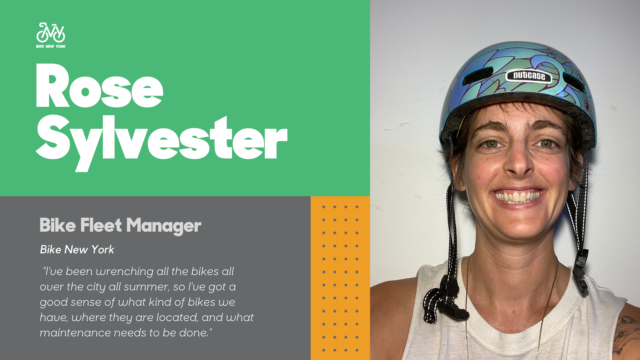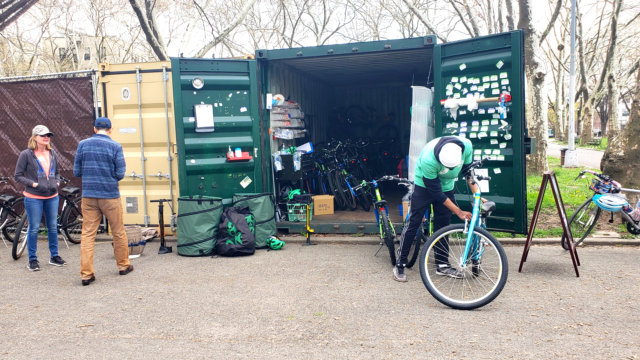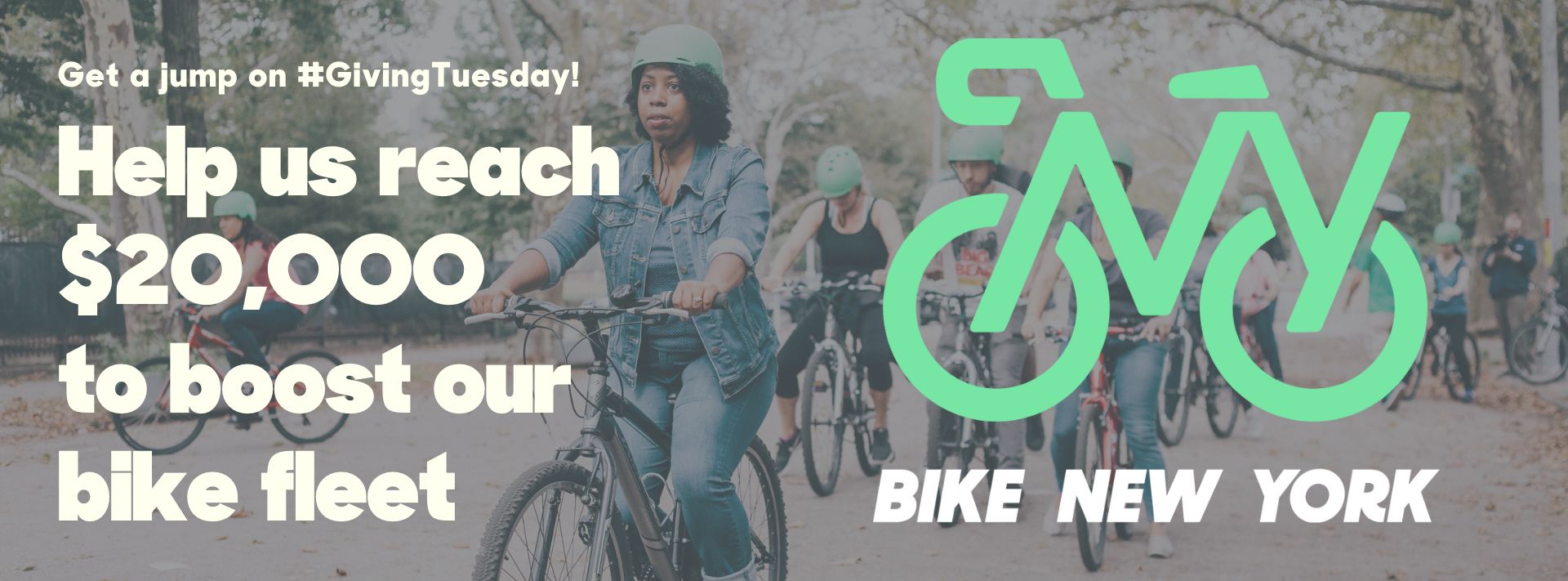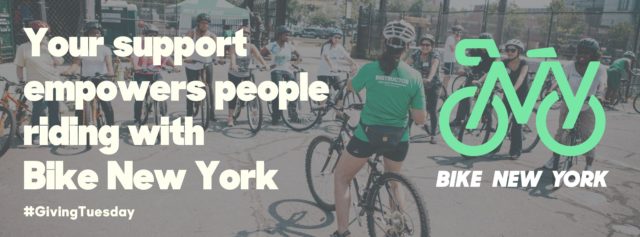November 1, 2022
The Woman Behind the Bikes: Rose Sylvester, Bike Fleet Manager
Bike New York’s Giving Tuesday campaign: Help us raise $20,000 to update our bike fleet.
We’re excited to kick off our Impact Blog series ahead of Giving Tuesday with an interview of our new Bike Fleet Manager, Rose Sylvester. Can you imagine being responsible for the maintenance of 500 bikes? Making sure that our Education Centers have safe bikes and repair equipment is no easy task. Today, we’ll learn what it takes to keep our bike fleet in tip-top shape, how Rose got started in the bike mechanic world, and how you can help us reach our Giving Tuesday goals!
For readers not familiar with how Bike New York runs its Community Education Centers: Every bike we use for our free bike education classes needs some love. These bikes are stored in big shipping containers at each class site. Rose regularly checks on these bikes and other equipment in the containers and ensures that the bikes are safe and in working order for class participants. Because of Rose’s work, students can feel comfortable and secure on our bikes as they learn to use them.
Meet Rose Sylvester
Now, let’s meet Rose. Born in Hawai’i with a Canadian mother, she moved back and forth between the United States and Canada growing up. She first got into biking while in college in Montreal, where riding around the city helped her have more control over where she was at any given time. There, she also joined a bike co-op and tinkered a bit with her bike, but it was when she moved to Toronto that she started wrenching.

Rose Sylvester, Bike Fleet Manager
I had a friend who spent a lot of time at a co-op and taught me. He handed me a frame and said, ‘Here, you should build this.’ I said, ‘What? I don’t know how to build a bike,’ and he told me he’d help me. When I first rode this bike that I ended up constructing from bits and pieces of parts around this co-op, I cried because I couldn’t believe I did this thing! Then, I became a bicycle courier and used that bike to earn an income. So it was a full-circle process. And I knew how to maintain it because I had built it. So it was such a satisfying experience.
When did you realize fixing bikes for a living was something you could do?
After Toronto, I moved back to Hawaii for a few months, and my stepmom had a bike that needed some repairs. So we took it to a local shop, and the owner had just injured himself. So he said, “Oh, it’s gonna be a few weeks till I can get around to this.” And I said, “I know how to do this, like, can I just fix it?” And he hired me as an apprentice because he couldn’t do as much because he had hurt his hand. And that’s when it happened. It didn’t even occur to me to work, but he wanted to hire me because I already had the skills. So I took it.
So you were in Hawaii working in this bike shop. How did you come to New York City and Bike New York?
I moved away from bikes for a while, then the pandemic happened, and I lost all three of my jobs. So it seemed like a good time to get back into bikes because everyone was biking now. It had been a while since I had been in a shop, but there was a shortage of mechanics, so I ended up getting a job and reorienting myself to being in a shop.
I worked at a shop in the city; the culture wasn’t what I wanted to be, and I wasn’t earning enough to make a living. But I ended up at this cool shop owned by another man from Hawaii in Brooklyn. A colleague who had gotten a job working at the Bloomberg bike build was talking about it. It sounded interesting, so I emailed Rich [Conroy, Bike New York’s Education Director], and I got in on that Bloomberg bike build. So Rich saw that this colleague of mine and I were skilled at the mechanical side, and he asked if we would stay on for the summer, and then it turned into the bike fleet manager job.
I’ve never been so respected as a bike mechanic as Rich has shown me. Noticing that I’m doing a good job, wanting to keep me on it, and paying me fairly. I have never been treated like this since getting into the industry, so when he gave me an opportunity to work in a full-time position for him, I was like, absolutely, how could I say no? Rich has been so wonderful to me.
We’ve talked a bit about how you got into mechanics, but can you explain what you do as a bike fleet manager?
It’s managing the maintenance of our fleets, located all over the city. I’ve been wrenching [fixing] all the bikes all over the city all summer, so I’ve got a good sense of what kind of bikes we have, where they are located, and what maintenance needs to be done.
People who don’t know how to ride are rough on bikes, which is great! We get sturdier bikes for that reason. My job is to figure out a system to ensure they are maintained as they’re being used and that the containers have all the supplies needed to run the programs. I’m excited because it’s a big problem I get to solve, and I can solve it!
How many bikes do we have on each container, and why is it important to maintain them?
We have around 500 bikes total and maintain the [New York City] Department of Education fleet. Safety comes first. Sometimes the bike only needs a minor adjustment–like a brake pad rubbing–and these small issues can make people think the bike is broken. And it might provide them with an experience where they don’t feel as confident or comfortable riding because the bike is doing something. They’re afraid it’s their fault, when usually only a slight adjustment must be made.

Bike fleet container at St Mary’s Park Education Center in the Bronx.
What projects do you want to tackle as a Bike fleet Manager?
I want to integrate the booking and maintenance systems into one software so that all our data is in one place so we can look at: how often different containers are being used; what supplies are running out; and what bike parts are getting broken the most, so we can have them on hand at the containers. That would be useful and make it so we have time to do other cool stuff. I’d like to streamline some detail-type stuff to give us more opportunities to run the programs we feel passionate about.
Do you have tips for people who don’t know how to cycle and want to start– other than joining our learn-to-ride classes–or those who know how to ride but might feel a little iffy about going out there?
I love that the parks here [like Central Park and Prospect Park] have those loops. They’re a place to learn how to ride because you can ride in a park on your own, but riding with other people gives you a sense of what it’s like to ride on a road.
And if you’re learning, don’t be afraid if people show interest in you; you’re not in trouble. They’re probably just trying to help! Cyclists love cyclists. We all want more cyclists. On the one hand, we want it to be less congested, so we want more cycling infrastructure. But we also want people to be on bikes.
If this interview inspired you to dive into bike mechanics, please check our Classes @ RAB. And remember, you can “Give a Fleet” with your support this November! Your donation can help us reach our goal of raising $20,000 to update our bike fleet. So donate today and help Rose and the Bike New York Team continue to provide free, safe bike education for New Yorkers in the five boroughs!



